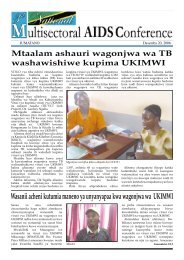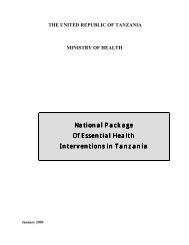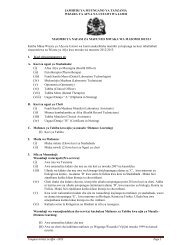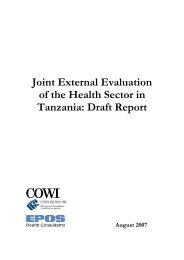Environmental and Social Management Framework for Tanzania ...
Environmental and Social Management Framework for Tanzania ...
Environmental and Social Management Framework for Tanzania ...
Create successful ePaper yourself
Turn your PDF publications into a flip-book with our unique Google optimized e-Paper software.
j) Projects on International Waterways (OP 7.50)<br />
Details of the ten World Bank's safeguard policies is provided in Annex 6.<br />
The Regional Health <strong>and</strong> TB Support Project triggers OP 4.01 on <strong>Environmental</strong><br />
Assessment. Resettlement of people (provided <strong>for</strong> by OP 4.12 - Involuntary<br />
Resettlement) will not occur under the project, although temporary use of people’s<br />
l<strong>and</strong> to facilitate access, construction <strong>and</strong> movement of vehicles is possible. This can<br />
easily be managed through proper planning <strong>and</strong> timing of activities as well as<br />
involvement of the affected people to avoid any loss of crops or property at the<br />
particular time of construction <strong>and</strong> in this regard, this ESMF provides <strong>for</strong> screening of<br />
project activities <strong>and</strong> sites to avoid triggering of this policy. The two policies are<br />
described in detail as follows:<br />
2.3.1 <strong>Environmental</strong> Assessment (OP/BP 4.01)<br />
The objective of <strong>Environmental</strong> Assessment is to ensure that projects are<br />
environmentally sound <strong>and</strong> sustainable, <strong>and</strong> that decision-making is improved<br />
through appropriate analysis of actions <strong>and</strong> mitigation of their likely environmental<br />
impacts. This policy is triggered if a project is likely to have potential adverse<br />
environmental risks <strong>and</strong> impacts in its area of influence. Construction <strong>and</strong><br />
rehabilitation of laboratory buildings may have negative environmental impacts,<br />
which require mitigation. There<strong>for</strong>e, in line with this Operational Policy, this<br />
environment <strong>and</strong> social management framework, <strong>for</strong> screening of the Regional<br />
Health <strong>and</strong> TB Support Project activities <strong>and</strong> sites has been prepared.<br />
2.3.2 Involuntary Resettlement OP/BP 4.12<br />
The policy acknowledges that development projects that displace people generally<br />
give rise to economic, social <strong>and</strong> environmental problems. Its objective there<strong>for</strong>e, is<br />
to avoid or minimize involuntary resettlement where feasible, by exploring all viable<br />
alternative project designs. OP 4.12 is intended to assist displaced persons in<br />
maintaining or improving their living st<strong>and</strong>ards. It encourages community<br />
participation in planning <strong>and</strong> implementing resettlement; <strong>and</strong> in providing assistance<br />
to affected people, regardless of the legality of title to the l<strong>and</strong> they posses, which<br />
has to be acquired <strong>for</strong> project activities. The Bank guidelines there<strong>for</strong>e, prescribe<br />
measures to minimize the negative impacts to ensure that the displaced community<br />
benefits from the project <strong>and</strong> to ensure that the affected persons are:<br />
• compensated <strong>for</strong> their losses at full replacement costs prior to the actual<br />
move;<br />
• assisted with the move <strong>and</strong> supported during the transition period in the<br />
resettlement site;<br />
• assisted in their ef<strong>for</strong>t to improve (or at least restore) their <strong>for</strong>mer living<br />
st<strong>and</strong>ards, income earning capacity <strong>and</strong> production levels;<br />
• integrated socially <strong>and</strong> economically in the host communities, so that<br />
adverse impacts in the host communities are minimized. This is best<br />
achieved through appropriate planning <strong>and</strong> consultation, involving affected<br />
people.<br />
20







